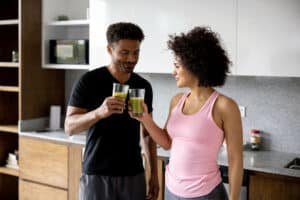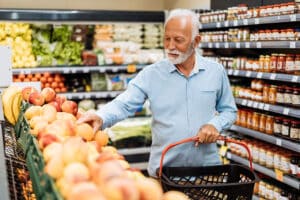Many consumers are familiar with the potential health hazards of plastic containers for foods and beverages. Harmful chemicals can leach into the foods or liquids stored in these containers and bottles. Of course, one remedy is to avoid plastic food containers and bags completely. But this is usually not practical for most of us, so here’s how to identify relatively safe plastics for storing food and drink.
Thanks to a resin ID code numbering system used for recycling purposes, anyone can judiciously determine safe plastics for storing food and drink based on their intended use. There are seven types of petrochemical resins used for containers. Each has a single digit number that is surrounded by arrows forming a triangle, usually at the bottom of the container.
Of those seven types, three must be avoided.
The Number 3 in the Triangle at the Bottom
The number 3 on a plastic item tells you it contains PVC or polyvinyl chloride. Plastics containing PVC are toxic, mostly due to the plastic softener DEHA used in processing them. Reports of small children having negative health reactions from chewing on soft plastic toys containing PVC drew attention to this.
Incinerating PVC plastics results in toxic dioxides being released into the air. Long term DEHA exposure is carcinogenic. If cancer doesn`t occur, liver problems and loss of bone mass are consequences linked to DEHA. A lot of flexible plastic containers and plastic bags or wraps use PVC/DEHA as a softener
The Number 6 at the Bottom
Styrofoam cups are numbered 6 for the toxic polystyrene from which they are made. Polystyrene is bad for the environment and your health, especially when used with hot liquids. Heat breaks the polystyrene into toxic styrene. This material is often used in cups containing soup concentrates that are brought to life with hot water, as well as in Styrofoam coffee and tea cups. Heated liquids are just what these cups need to poison you!
In case you’ve forgotten, heating any food or liquid in a plastic container, especially one numbered 3, 6, or 7, is an absolute no-no. This includes microwave cooking, an unhealthy activity in and of itself.
And the Number 7
The number 7 on the bottom of plastic containers or bottles indicates polycarbonates that often include BPA, or Bisphenol-A. There are occasions when BPA is not involved with number 7, but you’d have to check with the manufacturer and trust its claim. It may not be worth the effort unless you`re buying a plastic five gallon jug for water. Many of those are 7s.
BPA disrupts the balance of sex hormones because it acts as a xenoestrogen in the body. Women experience weight gain, migraines and reduced thyroid function because of elevated estrogen levels. Many breast cancer victims can attribute their cancers to hormonal imbalances.
Men who show high estrogen counts often age more quickly and lose their sexual vigor. Their accumulation of stomach fat is an indication of estrogen displacing testosterone. Prostate problems, including prostate cancer, are associated with sex hormone imbalances. Feminine characteristics in men can become more prevalent with too much estrogen.
For both men and women, the health hazards of estrogen dominance include loss of bone mass and decreased nerve health, possibly leading to dementia. Too much estrogen has a depressive effect on the body. The immune system is depressed, and emotional depression becomes more common. Hormone testing for bio-identical hormone replacement is the solution for any hormonal imbalance.
Going by the numbers is prudent for containers and bottles. The plastic containers and bottles with recycle code numbers 3 and 7 should be avoided, or if necessary used only for refilled purified water consumption. If you use the water quickly and each purified water refill remains in those three or five gallon jugs for a short time, chemical leaching is minimized.
Older scuffed up jugs or bottles should be discarded. They are more prone to being leached of petrochemical compounds. Styrofoam cups numbered 6 should be shunned completely or used only for holding nuts and bolts.
But What About Plastic Baggies and Wraps?
There are no numbers on those items. Yet there are times when some of us need to use wraps and baggies for storing food items. According to health journalist Melissa Breyer in her Care 2 article, there are three wrap and baggie brands that claim to be free from PVC or BPA. Those brands are Ziploc, Glad, and Saran. By the way, Tupperware items are usually without the toxic numbers 3, 6, and 7 as well.
There are many plastic bottles or jars, usually medium sized (one gallon or smaller), with the number 5 in the little triangle on the bottom. These are always a good find because they are considered one of the safest plastics around. It is found in yogurt tubs and many dishes used for food storage. Bottles and jars with 1’s and 4’s don’t seem to be around much. But it’s a pleasure to use those 5s whenever possible.
Sources Include:
http://www.care2.com/greenliving/which-plastics-to-never-use-with-food.html
http://www.thedailygreen.com/going-green/tips/polystyrene-stryrofoam-cups-460529
http://www.mindfully.org/Pesticide/PVC-Toys-Toxic.htm
http://www.buzzle.com/articles/hormone-imbalance-symptoms-in-women.html



